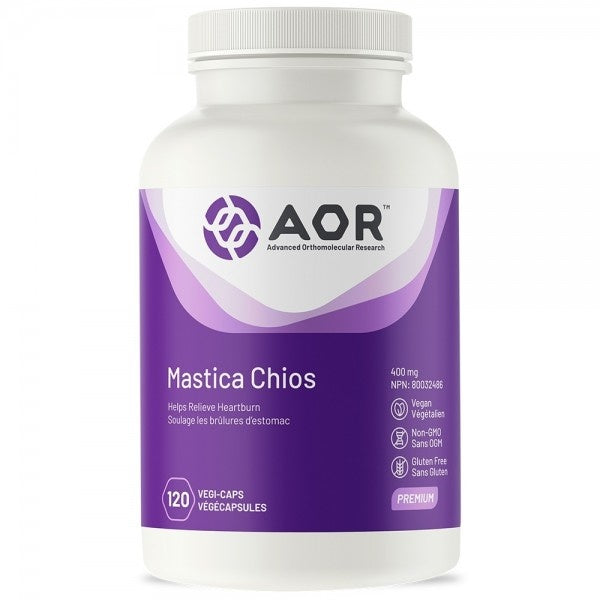
AOR Mastica Chios Mastic Gum 120 vcaps
Helps relieve heartburn
- A health-promoting gum resin derived from the Pistacia lentiscus tree
- Helps heal and soothe peptic and gastric ulcers
- Inhibits Helicobacter pylori
- Relieves gastric and intestinal inflammation
Mastic gum is the gummy resin of the mastic tree – Pistacia lentiscus, a relative of the pistachio tree. The mastic tree is found almost exclusively on the Greek island of Chios, the birthplace of Hippocrates, the traditional father of medicine. Mastic gum has historically been used in medicine to fight gastric and intestinal inflammation.
In modern society, mastic gum has proven useful for fighting gastritis and heartburn as well as overall gastric and intestinal inflammation. Studies have found that supplementing with mastic gum not only relieves the symptoms of these painful conditions but can actually help heal the stomach, possibly by killing H. pylori bacteria. Mastic gum is an excellent natural alternative for those who have experienced the negative long-term side effects of antacids, proton pump inhibitors, antibiotics and other medications that treat the symptoms of heartburn but not the cause.
AOR Advantage
AOR’s Mastica Chios is derived exclusively from mastic gum from the pistachio trees found on the Greek island of Chios.
Background
The Real Root of Stomach Lining Injury and Heartburn
For decades, it was believed that damage to the stomach lining was caused by having too much acid in the stomach. Spicy foods and stress were targeted as acidic culprits; antacids, or more powerful antisecretory drugs like omeprazole (Losec® or Prilosec®), were prescribed in order to suppress the body’s ability to make the “offending” stomach acid. Well, it’s true that the gnawing, burning pain of a damaged stomach lining flares up when acid burning into the injured stomach wall. But the acid doesn’t cause the damage itself. Instead, recent research has proven that most damage to the stomach lining is caused by germs – by an infection with the bacterium Helicobacter pylori.
Antacids Don’t Work on H. pylori
H. pylori is everywhere: about two thirds of the human family has caught the bug, which hides from the hostile environment of the stomach by bunkering down in folds in the lining of the stomach wall. People infected with H. pylori are somewhere between two and six times more likely to develop stomach diseases or mucosal associated-lymphoid-type (MALT) lymphoma, and are also more vulnerable to iron-deficiency anemia because of bleeding in the stomach.
This new knowledge has led to a revolution in the treatment of an injured stomach lining, which can now mostly be dealt with by using a cocktail of potent – but side-effect-prone – antibiotics. But centuries before medical science identified the role of H. pylori in causing damage to the stomach lining, and extending through the period in which untold millions wasted their time – and put their long-term health at risk – by using antacids and antisecretories. People in the Mediterranean and Middle Eastern world have been getting relief from their gastric problems using a powerful natural remedy that fights the invisible invader head-on – and wins.
Mastic Gum
Mastic gum is the gummy resin of the mastic tree – Pistacia lentiscus, a relative of the tree that gives us the pistachio. The mastic tree is found almost exclusively on the Greek island of Chios, the birthplace of Hippocrates, the traditional father of medicine. The use of mastic in medicine is attested by the Biblical prophet Jeremiah, and the thirteenth-century Arabic physicians Ibn Al-Jazzar Al-Qayrawani and Ibn Al-Baytar specifically extolled its virtues in fighting gastric and intestinal problems.
Additionally, evidence is mounting that in many cases infection with H. pylori also causes, or aggravates, heartburn (gastroesophageal reflux disease (GERD)). If that proves to be the case, then mastic may yet prove to provide soothing relief – and a real solution – for this miserable condition.
From the caravans of the ancient Near East to you: safe, natural, and real relief from digestive suffering.
Research
No side-effects were noted over the course of the studies using mastic gum for the treatment of digestive disorders involving damage to the stomach lining or gastrointestinal system. Indeed, it’s hard to see how side-effects could happen at these effective doses, since two-gram lumps of mastic are used safely as a breath-freshening chewing gum by people throughout the Mediterranean. Indeed, the UK government gave food producers carte blanche to use mastic in their products a quarter of a century ago.
Does mastic work by wiping out the noxious Helicobacter pylori bacterium? Two groups of scientists have found that mastic gum does indeed kill H. pylori in the test-tube, at concentrations easily attainable through such doses of the botanical. Studies are now being conducted by Dr. John Atherton and colleagues at the University of Nottingham to prove, with certainty, that this is exactly what’s happening in people taking mastic as a supplement. However it works, clinical studies show that the healing of digestive tract damage by mastic is very real.
Market Trends
In the Mediterranean and the Middle East, mastic gum has been used as a chewing gum, to fight bad breath, and in many types of foods. In North America, it is mainly known as a supplement to help reduce H. pylori infections and the damage caused.
FREE Canada Shipping on orders $150+
Estimated delivery: between 1-2 days in Ontario & Quebec, and 1-4 days Canada-wide.
Click here to view the full shipping policy >
We accept returns up to 30 days after delivery, if the item is unused and in its original condition, and we will refund the full order amount minus the shipping costs for the return.
If you have any further questions, please don't hesitate to contact us at info@wellnessmarketca.




